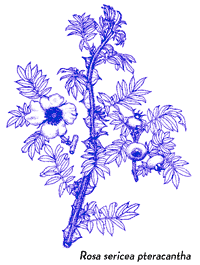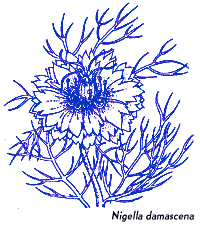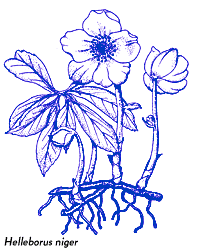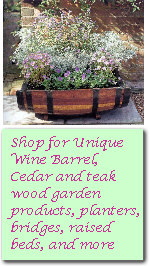Winter Gardening—Design Tips
that Work
by Patricia Jonas*
 Like most New Yorkers, I have a lot of practice utilizing every available inch
of living space, and for me that includes a garden—a 560-square-foot roof
terrace that is more than a third of my total space, and the principal reason I
live where I do. I don't put away the garden for winter: given the price of
Manhattan real estate, I can't simply forget about that much space for three or
four months. During the cold season, I do try to catch up on gardening books,
study catalogs, and plan for spring, of course. But with over 200 different
perennials, trees, and shrubs in containers, I always find reasons to be
outdoors.
Like most New Yorkers, I have a lot of practice utilizing every available inch
of living space, and for me that includes a garden—a 560-square-foot roof
terrace that is more than a third of my total space, and the principal reason I
live where I do. I don't put away the garden for winter: given the price of
Manhattan real estate, I can't simply forget about that much space for three or
four months. During the cold season, I do try to catch up on gardening books,
study catalogs, and plan for spring, of course. But with over 200 different
perennials, trees, and shrubs in containers, I always find reasons to be
outdoors.
Through a decade of trial and error, I've learned how to make
my rooftop a four-season garden, a place of beauty that entices me to abandon
the warmth of a fire and climb up two flights of stairs on even the shortest,
bleakest days. Unless you hibernate or live in the very coldest and snowiest of
climates, your garden, too—whether rooftop, container, or more conventional—can
be designed to be inviting in winter.
Without Bounds
Every garden is particular to its site, so a good place to
begin is with a description of mine. Enclosed on three sides, it is protected on
the east and west by fences, and on the north by the white stucco wall of a
penthouse. The view south is unobstructed, but undistinguished—not a view one
rushes to the parapet to admire. Nevertheless, there is a natural forward
movement to the edge that I have slowed by using groupings of containers to
break up the space and create diagonal lines and paths through the garden. The
deck is on two levels with a one-foot change in elevation, and raised beds built
into three corners (a door opens into the fourth).
I might have stopped there if I had heeded typical plant
palette recommendations for a rooftop. I stubbornly believed that although my
garden might be contained, it would not be limited; and I would make a garden as
rich and botanically interesting as a garden in the ground. So, I added more
containers: four large oblong cedar planters (two hold a rose arch); three
half-barrels; and about 65 additional planters of all sizes and shapes in wood,
terra cotta, ceramic, stone, fiberglass, aluminum, plastic, and wire.
Container Considerations
Like most gardeners, I love terra cotta. It is reckless, maybe
profligate, but I gamble and leave the sturdier pieces planted and outside in
winter. Manufacturers advise protecting terra cotta from frost, but in my Zone 7
container garden, only a few pots have disintegrated or cracked in ten years,
and only one was so expensive that I had any regrets—luck, maybe. I place the
more fragile pots in the shadow of the parapet, protected from direct sun and
the precipitous freezes and thaws that take a toll on both plants and pots.
The largest containers (for trees, shrubs, and roses) are
long-lasting oak half-barrels, and cedar and redwood planters. It's a quick
slide from beautifully weathered to falling apart, so I line wood planters with
plastic landscape fabric to extend their life. An added benefit is that the
plants dry out more slowly.
I also favor fiberglass planters that are reproduced in many
pleasing classic shapes and finishes, and are a fraction of the weight of terra
cotta and stone. Metal-impregnated fiberglass planters (available by mail-order
from Claycraft Planters, 212-242-2903) start with patinas of exceptional
character and actually age—a cast iron finish blends particularly well with
terra cotta.
Containers lifted an inch or two above the deck permit more
air circulation and prevent the bottom of the pots from freezing to the surface
below. This is what pot feet are made for, but I improvise by evenly wedging
pieces of scrap wood, branches, and pot shards under the pots so they don't
wobble. One of the great advantages of container gardening is the ability to
move plants into the limelight when they are looking their most glorious, and
backstage when they are fading. I rotate my pots for best display during spring
and summer, but in late fall I pull them all together in protective circles for
winter, and use bubble wrap to fill the gaps and insulate between them. In
December, I mulch with compost and lay evergreen branches over the pots.
While hardy plants remain in their containers throughout the
year—as they would in the open garden—I over-winter tender perennials indoors in
the pots too fragile to be left outside. I love the red blush the cold puts on
the leaves of scented geraniums, so I usually procrastinate before bringing them
in—sometimes until it is too late and they can't be separated from a frozen
lollipop of earth.
 Conspicuous Pods, Distinctive Vines
Conspicuous Pods, Distinctive Vines
Annuals are yanked up and composted during fall clean-up—no
frost-blackened stems, withered leaves, and flowers turned to mush to churlishly
advertise the end of the growing season. The only annuals that earn a reprieve
are those with conspicuous seed pods to decorate the garden throughout the fall
and winter. The clear sky-blue flowers of love-in-a-mist (Nigella damascena)
give way to fragile seed capsules surrounded by whiskery bracteoles. Well after
the reddish purple leaves of Perilla frutescens 'Atropurpurea' have
fallen, the aromatic maroon seed spikes of the square-stemmed, three-foot-tall
plants remain erect, and rustle in the wind through winter. Perilla self-seeds
so abundantly that it can be a nuisance, but this is another great advantage of
container gardening: most of the seed will not fall where it can germinate.
I apply the same rule to herbaceous perennials that die back
to the ground that I do to spent annuals. During fall clean-up, I rid the garden
of debris that might harbor overwintering insects and diseases. But I spare lots
of seed heads and stems to remind me this is a quiet, not a dead, season, with
plants living in seeds and under their mulch of boughs. I allow hips to ripen
brick-red on the fall-blooming roses; the tiny, fluffy seed heads of Aster
lateriflorus to linger on mounds of wiry stems; the polished mahogany
rattles of Iris sibirica to tower on their sturdy stalks; and the
garnet-brown, seedhead-topped spears of Penstemon digitalis 'Husker Red'
to stand above semi-evergreen purple foliage.
Annual vines also do double duty as winter showpieces.
Love-in-a-puff (Cardiospermum halicacabum) will cover a trellis in summer
with bright green ferny foliage, but the real display begins in autumn when
inconspicuous white flowers are followed by inflated seed capsules -- little
balloons that cling to their vines all winter. The large pure white
night-blooming flowers of the moonflower (Ipomoea alba) are not its only
striking feature: left to ripen and harden, the fig-shaped seed capsules and
twining vine decorate a fence and hang over the bare branches of a small peach
tree.
Good Bones
A great deal has been written about how winter reveals the
"bones" of the garden. Every garden needs a framework, of course, but the
container garden can look especially desolate in winter with no trees or shrubs
to anchor it. Noble shapes of conifers are particularly important in winter, and
can add color as well as mass. The blue-gray foliage of Juniperus scopulorum
'Wichita Blue' and yellow-gold foliage of Chaemacyparis obtusa 'Crippsii'
are an electrifying combination in full sun, and there are many other widely
available, slow-growing conifers quite adaptable to container culture. If you
are a container gardener, stay away from conifers not hardy to at least one zone
colder than yours, and pay special attention to the species' sensitivity to
wind.
A protected site for evergreens is extremely important.
Variegated Daphne burkwoodii 'Carol Mackie' is beautiful throughout the
year, but glows in winter light in a partially shady spot it shares with a
diminutive Daphne cneorum 'Pygmaea Alba', whose fragrance scents the air
in early spring. All evergreens continue to transpire through winter, and
broad-leaf evergreens, especially, will be scorched if they lose excessive
moisture to cold, drying winds. If a particularly harsh season is predicted,
erect windbreaks. Or wrap the most vulnerable specimens entirely with burlap or
a new polypropylene fabric called Bush Jacket (manufactured by Circlemoon
Products and available through nurseries and garden centers), which is lighter,
easier to handle, and more durable than burlap. Applications of anti-desiccant
spray will also help. Above all, give plants a chance by keeping them well
watered as they go into the cold season, and water on warm days during dry
winters.
Bark and Branches
Choose deciduous trees and shrubs for interest in every
season: not just for flowers and foliage, but for fragrance, interesting bark,
fruit that persists through winter, and stems and branches that gracefully trace
the sky. Complex branching patterns of an Acer palmatum hold the eye when
the trees are bare, and the texture of papery exfoliating bark (the orange-brown
bark of Acer griseum or the light tan and darker cinnamon-brown bark of
Heptacodium miconioides, the seven-son flower) suits the season.
Seven-son flower also has white flowers in autumn followed by remarkable small
purple fruit held on its graceful peeling branches. After its leaves and
purple-pink flowers fall, the arching, five-foot silvery stems of Lespedeza
thunbergii 'Gibraltar' cascade like a frozen fountain. In very early spring,
spring snowflake (Leucojum vernum) emerges with the tips of its white
bells adorned with tiny drops of spring green.
 Bewitching
Witchhazel
Bewitching
Witchhazel
There are plants at other times of the year that equal their
perfume, but nothing commands the stage like witchhazels when they debut in
winter. If I had space I would grow three species: fall-blooming Hamamelis
virginiana with bright yellow flowers, followed in January through March by
the coppery orange-flowered Hamamelis x intermedia 'Jelena' and
deep yellow- and bronze-flowered Hamamelis mollis. An underplanting of
evergreen or semi-evergreen plants like barrenwort(Epimedium species),
bigroot geranium (Geranium macrorrhizum), or Bergenia—all of which
color bronze to red in winter—complement the scale and shades of the witchhazels.
Patience is required to get them established, but hellebores are also good
companions for witchhazels. They are among the very first herbaceous plants to
flower; Christmas rose (Helleborus niger) begins blooming as the
witchhazels fade, and the more uncommon Helleborus argutifolius is a
standout all winter. Its green apple-colored flowers look especially fine with
faintly scented white snowdrops (Galanthus nivalis).
There are very few plants I won't try in a container, and I
often put their adaptability to the test. In fact, the smaller size of some
trees and shrubs that will grow larger and more vigorously in the ground is
perfectly suited to the scale of my garden. The most important thing I look for
is interest in four seasons, and I haven't even begun to scratch the surface of
plants that can pay the rent. What I've learned over the years is that there is
no reason to put your garden away for the winter. With a little imagination and
design savvy, a garden, no matter what its size or style, can offer beauty and
pleasure all year round.
*Patricia Jonas, as Director
of BBG's Gardener's Resource Center,
Pat, who has a certificate in horticulture, enjoys the challenge of sharing her
expertise with fellow plant fans.
![]() Gardeners' Corner
Kids'
Garden
Sustainable Garden
Contact Us
Gardeners' Corner
Kids'
Garden
Sustainable Garden
Contact Us![]()


 Like most New Yorkers, I have a lot of practice utilizing every available inch
of living space, and for me that includes a garden—a 560-square-foot roof
terrace that is more than a third of my total space, and the principal reason I
live where I do. I don't put away the garden for winter: given the price of
Manhattan real estate, I can't simply forget about that much space for three or
four months. During the cold season, I do try to catch up on gardening books,
study catalogs, and plan for spring, of course. But with over 200 different
perennials, trees, and shrubs in containers, I always find reasons to be
outdoors.
Like most New Yorkers, I have a lot of practice utilizing every available inch
of living space, and for me that includes a garden—a 560-square-foot roof
terrace that is more than a third of my total space, and the principal reason I
live where I do. I don't put away the garden for winter: given the price of
Manhattan real estate, I can't simply forget about that much space for three or
four months. During the cold season, I do try to catch up on gardening books,
study catalogs, and plan for spring, of course. But with over 200 different
perennials, trees, and shrubs in containers, I always find reasons to be
outdoors. Conspicuous Pods, Distinctive Vines
Conspicuous Pods, Distinctive Vines Bewitching
Witchhazel
Bewitching
Witchhazel